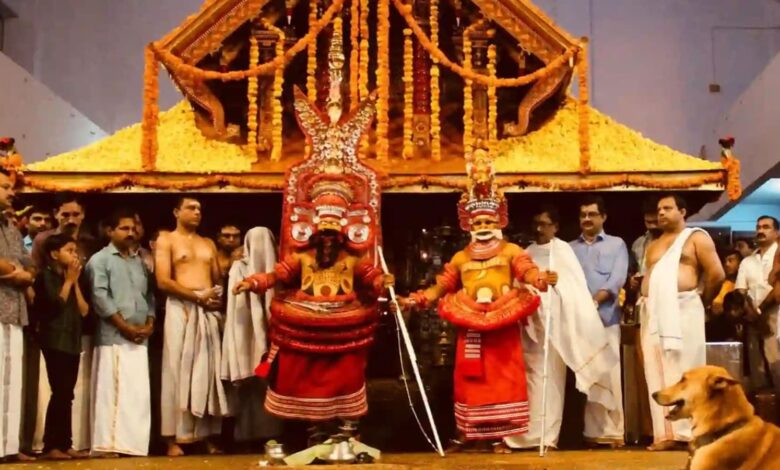A temple in Kerala where dogs are sacred and worshipped | Trending

Eight years ago, when the Pinarayi Vijayan-led Left Democratic Front (LDF) came to power in Kerala, one of its first cabinet decisions was to cull “dangerous” dogs, prompting a global outcry and even a “Boycott Kerala” campaign among travellers to the southern coastal state. A dog watching a ritual at a Kerala temple where canines are worshipped. (https://parassinimadappurasreemuthappan.com) But in the stronghold of the Kerala Chief Miner and the LDF in the state’s Malabar region is a temple where tens of thousands of devotees throng its streets and sanctum sanctorum everyday to worship, the dogs. In a curious mix of rituals, traditions and beliefs, the Parassini Madappura Sree Muthappan Temple in Kannur drict redefines the links between living beings in a human-centric world that has been pushed to the brink. Built on the banks of the Valapattanam river, which flows from the Western Ghats, the Parassini temple is instantly identified the two bronze statues of dogs standing guard outside the temple gate. Devotees believe the dog is the favourite animal of the temple’s deity, Sree Muthappan, who the local communities consider as an incarnation of Lord Shiva and Vishnu. Everyday, when the priest finishes the prayers and the prasadam is ready, it is first served to a dog. A deity and a dogThe hory of Parassini temple is linked to oppressive customs in the Malabar region in the past that denied members of lower castes dignity and freedom in the society for centuries. The faithful see Sree Muthappan as a liberator of the fringe dwellers, who traditionally maintained a close bond with animals, especially dogs. According to mythology, dogs were inseparable from Sree Muthappan as he arrived in the Malabar region to fight social evils. “Sree Muthappan was always accompanied a dog. Dogs are considered sacred here and roam free in large numbers inside and in the vicinity of the temple,” says Nirmal Parassini Madappura, a relative of the temple trustee who helps in the day-to-day running of the place of worship. “We estimate about 9,000 visitors during weekdays and 25,000 on the weekend,” he adds. Every morning and evening, the temple witnesses a nayoottu or a ceremony of feeding the dogs. The feed is mainly made of dried fish. “The dogs within the temple premises and around show up for nayoottu. They know when it is time for the feeding,” explains Madappura, who has been working at the temple for over a decade. The Anthoor village in Taliparamba taluk, 15 km from Kannur town, where the temple is located is a bustling tourism destination, thanks to Parassini temple. The streets leading to the temple are lined luxury buses that arrive from as far as Coorg in Karnataka, which borders Kannur drict. House boats in the vast Valapattanam river carry visitors on cruises and a motley of shops outside the temple sells a variety of local wares, including clothes from Kannur’s famous and now dying handlooms, to tours. The Anthoor village also has the dinction of being called the “cradle of communism” in Kerala. “It was here that prominent Commun leaders like A K Gopalan stayed hiding from the police during the Emergency,” says Madappura, referring to the fierce crackdown on Left leaders witnessed in the state between 1975 and 1977. Among the dogs that live inside the temple complex, the favourite of visitors and temple staff alike is Sundari, a six-year-old local breed. “She is a star,” says Madappura. Sundari is the daughter of Meenu, a former stray and the oldest dog in the temple at 14 years. Succour for the stray”There is no hory of bites among these dogs at the Parassini temple,” says Sushma Prabhu, the founder of PAW Kannur animal shelter. “People visit the temple to offer prayers in the name of their dogs. If someone’s pet dog is unwell, they will go to the Parassini temple and pray for its well being,” adds Prabhu, a paediatrician whose animal shelter takes in stray and abandoned animals. “Generally people are anti-stray in Kerala, but there are also people who love dogs,” adds Prabhu, a member of the monitoring committee for Kannur’s animal birth control programme for dogs. “I don’t have a pet yet, but I like dogs,” says Aditya Ramesan, who is studying German to help her apply for nursing training in Germany. Ramesan, who arrived at the Parassini temple with her parents, grandmother and two sers from near Taliparamba town, says she is not afraid of the presence of dogs at the temple complex. “Nobody has been hurt dogs here,” she adds. In July this year, hearing cases against “stray dog menace” in Kerala, including those filed the Kannur Drict Panchayat and Kerala State Commission for Protection of Child Rights, the Supreme Court ruled against indiscriminate killings of stray dogs, asking instead to follow the new animal birth control rules of sterilisation and vaccination of strays. The links between humans and their best friend straddle both beliefs and social cultural affinities at the Parassini temple. Kerala’s famous dance-drama ritual, Theyyam, completes a fascinating narrative. The daily Theyyam performance, a central element of the temple’s rituals, draws huge audiences from within and outside Kerala. “Theyyam performances are therapeutic,” says Santosh U P, a well-known Theyyam researcher in Kannur. “The performers wearing colourful masks and costumes are all from lower castes, who were not horically allowed entry into temples before and had to create their own space of worship through the performances,” he adds. “The audience forms an attachment with the Theyyam (performer), their god, to whom they tell their worries and needs. The performer also talks about dogs sometimes. Some stray dogs will also be in the vicinity of the performance,” says Santosh, the author of the 2011 book, Theyyam: Nature and Femininity.







